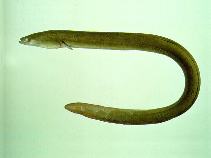http://www.fishbase.org/Summary/speciesSummary.php?genusname=Anguilla&speciesname=japonica ---> http://192.134.151.83/Summary/speciesSummary.php?genusname=Anguilla&speciesname=japonica
http://192.134.151.83/Summary/speciesSummary.php?genusname=Anguilla&speciesname=japonica ---> https://fishbase.mnhn.fr/Summary/speciesSummary.php?genusname=Anguilla&speciesname=japonica
https://fishbase.mnhn.fr/Summary/speciesSummary.php?genusname=Anguilla&speciesname=japonica ---> https://fishbase.mnhn.fr/summary/Anguilla-japonica.html
Anguilla japonica, Japanese eel : fisheries, aquaculture

You can
sponsor
this page
Common name (e.g. trout)
Genus + Species (e.g. Gadus morhua)
-

-
About this page
-
Languages
-
User feedbacks
-
Citation
-
Uploads
-
Related species
-


 Japanese eel
Add your observation in
Fish Watcher
Upload your
photos
and
videos
Japanese eel
Add your observation in
Fish Watcher
Upload your
photos
and
videos
Pictures
|
Stamps, Coins Misc.
|
Google image
 Anguilla japonica
Anguilla japonica
Picture by
Shao, K.T.
Teleostei (teleosts) >
Anguilliformes
(Eels and morays) >
Anguillidae
(Freshwater eels)
Etymology:
Anguilla:
Latin, anguilla, .-ae = eel (Ref.
45335
)
.
More on authors:
Temminck
&
Schlegel
.
Environment: milieu / climate zone / depth range / distribution range
Ecology
Marine; freshwater; brackish; demersal; catadromous (Ref.
51243
); depth range 1 - 400 m (Ref.
6898
). Subtropical; 4°C - 27°C (Ref.
12468
); 46°N - 15°N, 105°E - 170°E
Asia: Japan to the East China Sea, Taiwan, Korea, China and northern Philippines. Spawning grounds of this species are presumed to be in the western Mariana Islands, at a salinity front near 15°N and 140°E (Ref.
54488
). Most expensive food fish in Japan. Introduced elsewhere.
Size / Weight / Age
Maturity: L
m
?
range ? - ? cm
Max length : 150 cm TL male/unsexed; (Ref.
9828
); common length : 40.0 cm SL male/unsexed; (Ref.
35840
); max. published weight: 1.9 kg (Ref.
82795
)
Vertebrae
: 114 - 118. Plain-colored.
Spawning occurs in the sea; small eels ascend the rivers in schools; develop and grow in freshwater. The species may crawl over land at night from one place to another (Ref.
5258
,
11230
). Adults feed on crustaceans, insects and fish (Ref.
5258
). Maximum weight given (1889 g) has a maximum length of 100.8 cm TL in Ref. 82795. Utilized fresh, smoked, canned and frozen; eaten steamed, broiled and baked (Ref.
9988
). Used in Chinese medicine (Ref.
12166
).
Life cycle and mating behavior
Maturity
|
Reproduction
|
Spawning
|
Eggs
|
Fecundity
|
Larvae
Assuming reproductive mode to be the same as that of
Anguilla anguilla
.
Masuda, H., K. Amaoka, C. Araga, T. Uyeno and T. Yoshino
, 1984. The fishes of the Japanese Archipelago. Vol. 1. Tokai University Press, Tokyo, Japan. 437 p. (text). (Ref.
559
)
IUCN Red List Status (Ref.
130435
)
Endangered (EN)
(A2bcd); Date assessed:
06 November 2018
CITES
Not Evaluated
Not Evaluated
Threat to humans
Harmless
Human uses
Fisheries: highly commercial; aquaculture: commercial
FAO - Aquaculture:
production
,
species profile
; Fisheries:
landings
,
species profile
; Publication:
search
|
FishSource
|
Sea Around Us
More information
Countries
FAO areas
Ecosystems
Occurrences
Introductions
Stocks
Ecology
Diet
Food items
Food consumption
Ration
Common names
Synonyms
Metabolism
Predators
Ecotoxicology
Reproduction
Maturity
Spawning
Spawning aggregation
Fecundity
Eggs
Egg development
Age/Size
Growth
Length-weight
Length-length
Length-frequencies
Morphometrics
Morphology
Larvae
Larval dynamics
Recruitment
Abundance
BRUVS
References
Aquaculture
Aquaculture profile
Strains
Genetics
Electrophoreses
Heritability
Diseases
Processing
Nutrients
Mass conversion
Collaborators
Pictures
Stamps, Coins Misc.
Sounds
Ciguatera
Speed
Swim. type
Gill area
Otoliths
Brains
Vision
Tools
E-book
|
Field guide
|
Identification keys
|
Length-frequency wizard
|
Life-history tool
|
Point map
|
Classification Tree
|
Catch-MSY
|
Special reports
Check for Aquarium maintenance
|
Check for Species Fact Sheets
|
Check for Aquaculture Fact Sheets
Download XML
Summary page
|
Point data
|
Common names
|
Photos
Internet sources
AFORO (otoliths)
|
Alien/Invasive Species database
|
Aquatic Commons
|
BHL
|
Cloffa
|
BOLDSystems
|
Websites from users
|
Check FishWatcher
|
CISTI
|
Catalog of Fishes
:
genus
,
species
|
DiscoverLife
|
ECOTOX
| FAO - Aquaculture:
production
,
species profile
; Fisheries:
landings
,
species profile
; Publication:
search
|
Faunafri
| Fishipedia |
Fishtrace
| GenBank:
genome
,
nucleotide
|
GloBI
|
Google Books
|
Google Scholar
|
Google
|
IGFA World Record
|
MitoFish
|
National databases
|
Otolith Atlas of Taiwan Fishes
|
PubMed
| Reef Life Survey | Socotra Atlas |
Tree of Life
| Wikipedia:
Go
,
Search
|
World Records Freshwater Fishing
|
Zoobank
|
Zoological Record
Estimates based on models
Preferred temperature (Ref.
123201
): 2.5 - 23.3, mean 17 °C (based on 432 cells).
Phylogenetic diversity index (Ref.
82804
): PD
50
= 0.5000 [Uniqueness, from 0.5 = low to 2.0 = high].
Bayesian length-weight: a=0.00062 (0.00039 - 0.00099), b=3.18 (3.05 - 3.31), in cm total length, based on LWR estimates for this species & Genus-body shape (Ref.
93245
).
Trophic level (Ref.
69278
): 3.6 ±0.51 se; based on food items.
Generation time: 15.7 ( na - na) years. Estimated as median ln(3)/K based on 1
growth studies.
Resilience (Ref.
120179
): Low, minimum population doubling time 4.5 - 14 years (K=0.07).
Fishing Vulnerability (Ref.
59153
): High to very high vulnerability (71 of 100).
Price category (Ref.
80766
):
Unknown
.
Nutrients (Ref.
124155
): Calcium = 32.7 [19.9, 65.7] mg/100g; Iron = 0.741 [0.434, 1.157] mg/100g; Protein = 19.5 [17.7, 21.4] %; Omega3 = 0.35 [0.19, 0.67] g/100g; Selenium = 55.1 [28.6, 103.5] μg/100g; VitaminA = 8.74 [1.85, 42.36] μg/100g; Zinc = 0.685 [0.498, 0.991] mg/100g (wet weight); based on
nutrient studies.
Back to Search
Random Species
Back to Top
Accessed through:
Not available
FishBase mirror site :
localhost
Page last modified by :
mrius-barile
- 20 July 2016
Fatal error
: Uncaught ArgumentCountError: Too few arguments to function checkEcotox(), 1 passed in /var/www/html/summary/speciessummary.php on line 2304 and exactly 3 expected in /var/www/html/includes/speciessummary.lib.php:2579 Stack trace: #0 /var/www/html/summary/speciessummary.php(2304): checkEcotox() #1 {main} thrown in
/var/www/html/includes/speciessummary.lib.php
on line
2579
|